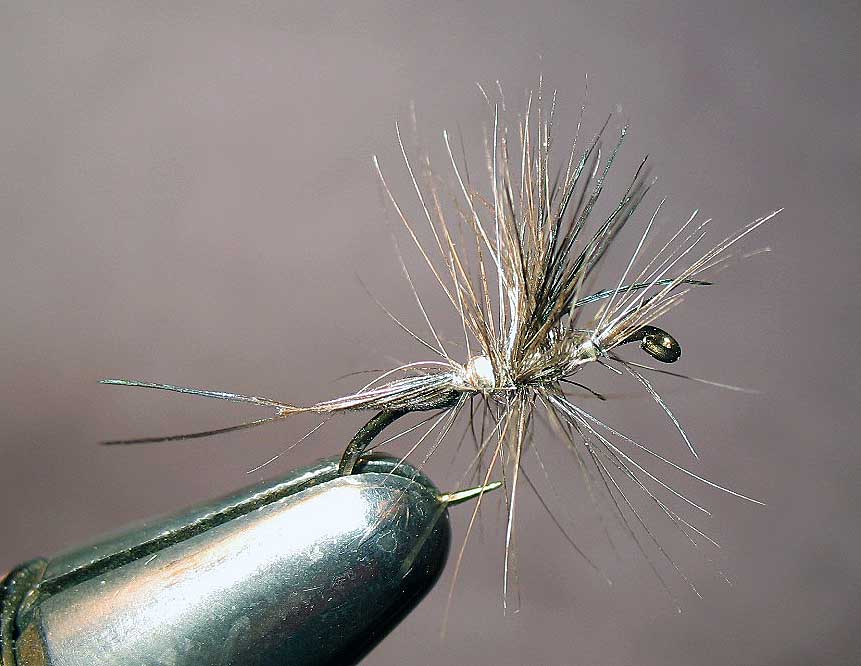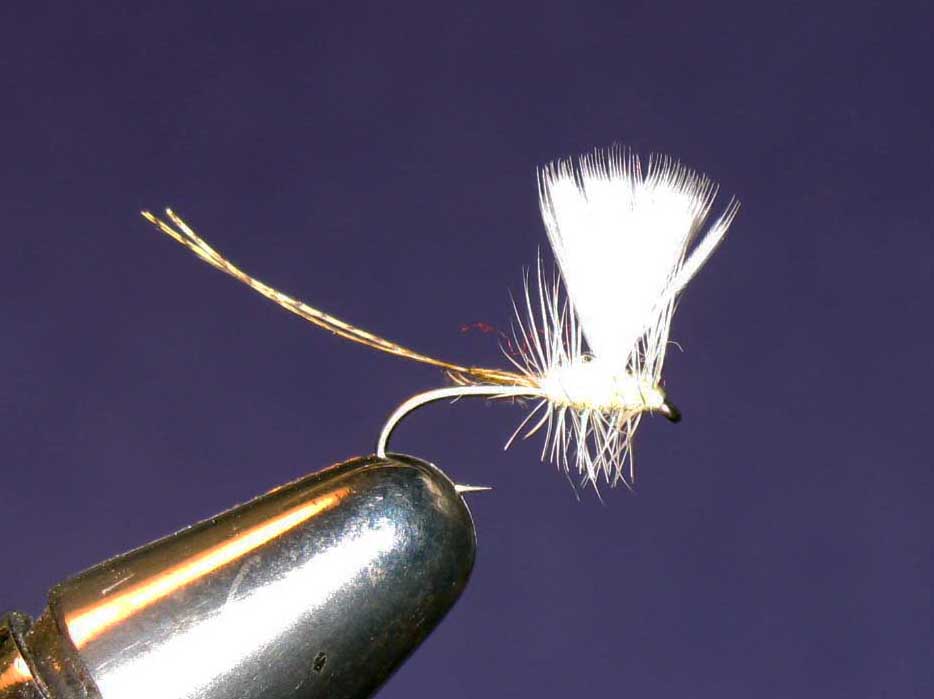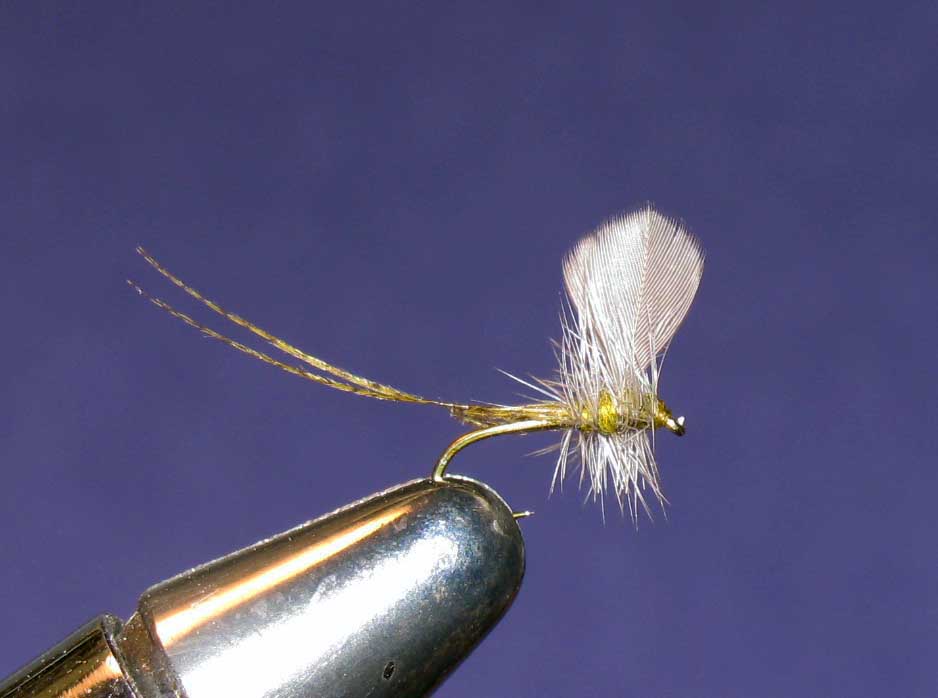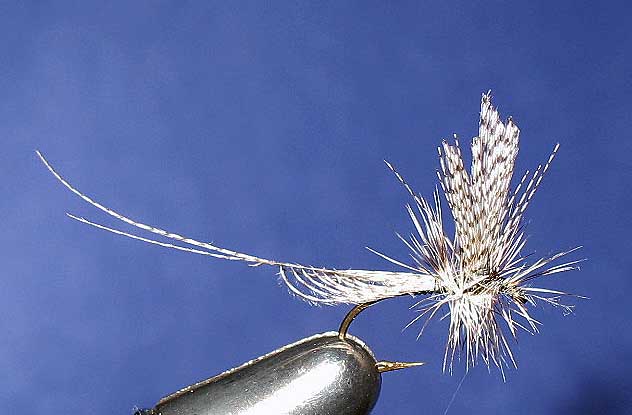February 2009--AHatchmaster(a.k.a., Hatchmatcher, Marv Slind | ||
and Grizzly Hackle 
Chinese Pheasant Neck Feather and Blue Dun Hackle |
Pattern: | |
|
Hook: Dry fly hook (Mustad 94840, etc), size 12 Thread: 6/0 black (or as appropriate for body color) Tail: Two fibers from mallard flank feather (see tying instructions below) Body: Remaining fibers of mallard flank feather, fibers stroked downward to base of quill Wing: Tips of fibers from body, tied upward to form wing and trimmed to appropriate height Hackle: Grizzly or white | ||
|
| ||
|---|---|---|
|
From a mallard flank feather, cut the quill near the end to form a "V"
(cut only the quill, so that the remaining fibers
at the cut are intact).
Using a dubbing needle, separate out the last fiber on each side of the quill--these
form the tails. Stroke the remaining fibers down to the base of the quill to form the
body, and tie onto the hook. Tie the fiber tips that are now pointing toward the eye of the hook upright to form the wing, and trim to the appropriate height. Palmer hackle behind and in front of the wing, and whip finish to form the head. (If you prefer a divided wing, separate the upright fibers and divide using a figure-eight wrapping with tying thread.) The hardest part of this pattern is separating the hackle fibers and tying them forward. After that, the pattern is a "snap" to tie. I find it easier to tie the feather onto the hook first (with the hackle fibers tied forward), and then cut out the "V" to form the tail--but when you do that, you need to be VERY careful when you cut the stem so that you leave two fibers for the tail. Otherwise, you'll have to start over from scratch. The mallard feather can be dyed appropriate colors to imitate a variety of mayflies, using hackle colors to match. By selecting smaller feathers, you can imitate smaller mayflies. The metallic green feather from the neck of a ring-necked Chinese pheasant can also be substituted where appropriate for a smaller, darker body. This fly was apparently first developed by Harry Darbee in the late 1930's for use in the Catskills. It was later popularized in the West by Dick Alf, for use on the spring creeks around Sun Valley, Idaho, including Silver Creek. It was included in early editions of the Inland Empire Fly Fishing Club's excellent little pattern guide, Flies of the Northwest (but not in their most recent edition). Steve Raymond sings its praises as a Callibaetis spinner imitation for still water fishing in the West (using the green pheasant feather and black hackle to imitate the "blue upright"). The pattern has the advantage of letting you imitate a large mayfly with a fly that's almost "as light as a feather." I was shown this pattern when I took a fly tying class in 1982, but I'd forgotten about it until last fall, when I was searching frantically for something to use during the "white fly" hatch on the Upper Iowa. I found a couple of these tucked away in an old fly box. When I tied one on my tippet and made my first cast, I was immediately convinced that the plain, undyed mallard feather makes an excellent pattern for use during the fall Ephoron leukon ("white fly") hatch throughout the Driftless area. Steve Raymond's descripton of the fly can be found in Blue Upright: The Flies of a Lifetime (Guilford, Connecticut, The Lyons Press, 2004). Click here to see a useful video showing how to tie this fly, demonstrated by Scottish tyer Davie McPhail. |
||
|
This past summer (2011), I was browsing through the fly selections in some of the fly shops near the Henry's Fork in Idaho. Much to my pleasant surprise, I found a couple varieties of this pattern, specifically targeting Blue Winged Olives and Pale Morning Duns. I don't know who the commercial tyer is who is responsible for these, but they give a couple good examples of the versatility of this fly.
| |
 Blue Winged Olive |  Pale Morning Dun |
